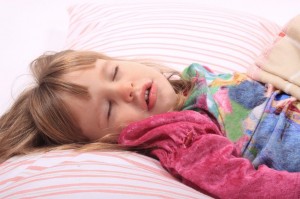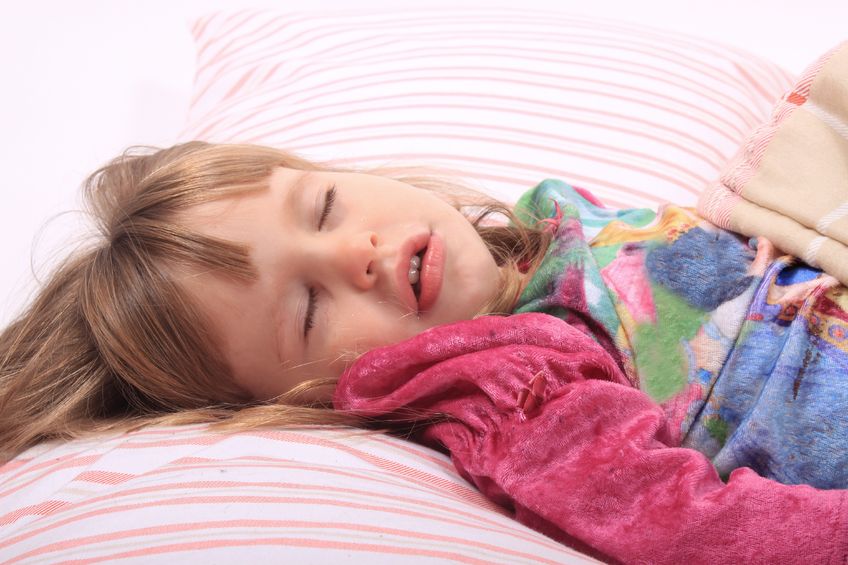When you think of sleep apnea, you may not think of children having this chronic sleep disorder. The fact is that snoring and sleep apnea are more becoming increasingly common conditions that affect children. The signs may be surprising, but it is helpful to know what to look for:
1. Sleepwalking. It affects about 10% of children at least once between the ages of 3 and 10, typically peaking around the age of 5 and becomes less frequent through adolescence. Sleepwalking may not always be apparent as it may associated with confused arousal, but it may occur as a consequence of sleep apnea. Sleep apnea can lead to brief awakenings to resume breathing.
2. Nocturnal Teeth Grinding. Sleep apnea frequently occurs when the soft tissues (tonsils, adenoids, soft palate, and tongue) at the back of the throat block the airway. Clenching, gnashing, or grinding teeth may be a way that the body subconsciously maintains an open airway.
3. Bedwetting. Children often times wet the bed as they are being potty trained. It is only considered to be a problem if it occurs twice a week beyond the age of years old. Sleep enuresis, as it called, occurs during slow-wave sleep when there is a failure to awaken when the bladder is full. It typically affects boys more often that girls, and sleep apnea treatment will most likely put an end to bedwetting.
4. Sweating. It is not normal for children to wake up regularly drench in sweat. If your child’s pajamas, sheets or pillow are soaked through, this may be evidence that your child is struggling to breathe during sleep. The sweating is left behind after all the hard work throughout the night when they should be resting.
5. Restless Sleep. If your child is restless during sleep, excessively moving, it is another sign of struggles during the night. Breathing is difficult with sleep apnea, and the struggle to breath may manifest itself in movements during sleep. If the covers are twisted into a ball at the base of the bed or on the floor in the morning, this could be a sign of distress. Also, look for frequent changing of odd sleeping positions such as being upside down, parallel to the headboard or being propped up.
6. Snoring. Regularly snoring among children is a red flag. Snoring due to a cold is normal, but children should never consistently snore. This is a sign of an abnormal flow of air through the upper airway that extends from the nose and mouth to the lungs. It is turbulence in this passage that produces the sound. It may occur due to sleep apnea, allergies, enlarged tonsils or adenoids, and other problems that can be fixed.
7. Growth problems. Every time you bring your child to the pediatrician, weight and height are measured, recorded, and often graphed onto a page called a growth curve. This curve shows percentiles of these measures, making comparisons based on age and sex. When a child “falls off the growth curve” this may be a sign of trouble. During slow-wave sleep, the growth hormone is released. During disrupted sleep, which occurs in sleep apnea, less of the growth hormone is released.
8. Naps. It is normal for children to stop taking naps. When they don’t, it could suggest a problem with the quantity or quality of sleep they get at night. It is very unusual for older children to require regular naps during the day, and excessive daytime sleepiness among this group requires further evaluation.
9. ADHD. Attention deficit hyperactivity disorder (ADHD) is a fairly common diagnosis in children, and sleep apnea may be one of the reasons being the increasing diagnosis’s. Children with ADHD experience difficulty paying attention, hyperactive behaviors, forgetfulness, poor impulse control or impulsivity, and distractibility. Unlike adults who are sleepy and say so when they are a sleep deprived, children are hyperactive.
10. Mouth Breathing. Humans are obligate nasal breathers, meaning that we are meant to breathe through our nose. If the nose is chronically obstructed due to allergies or a deviated nasal septum, mouth breathing may result. When we breathe through our mouth the muscles of our jaw are in a relaxed position, which can contribute to weakness in the tongue and other muscles of the mouth and throat. Snoring and sleep apnea are more likely occur in mouth- breathers.
If you are concerned that your child may have any signs of sleep issues, always consult your pediatrician. Doctors often times may not bring up sleep problems so it is important to be proactive. Ensure that your child is getting the best quality of sleep possible. Gallery Furniture believes in our young minds of the future!



No comments yet.